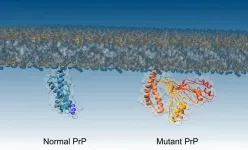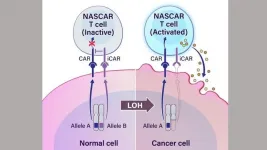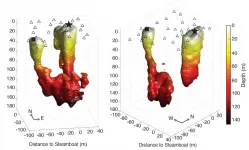(Press-News.org) Some invasive species targeted for total eradication bounce back with a vengeance, especially in aquatic systems, finds a study led by the University of California, Davis.
The study, published today in the journal PNAS, chronicles the effort --and failure -- to eradicate invasive European green crabs from a California estuary. The crabs increased 30-fold after about 90 percent had been removed. The study is the first experimental demonstration in a coastal ecosystem of a dramatic population increase in response to full eradication.
"A failure in science often leads to unexpected directions," said lead author Edwin (Ted) Grosholz, a professor and ecologist with the UC Davis Department of Environmental Science and Policy. "We slapped our foreheads at the time, but with thought and understanding, it's told us a lot about what we shouldn't be doing and provided a way forward for us. The world should get less focused on total eradication and work toward functional eradication."
"Functional eradication" is described in a study led by the University of Alberta, co-authored by Grosholz, and published in the March issue of Frontiers in Ecology and the Environment. The authors consider this a more effective approach to invasive species management, particularly regarding species for which total eradication is unlikely.
EXPLOSION
For the PNAS study, researchers in 2009 began intensive efforts to eradicate the European green crab from Stinson Beach's Seadrift Lagoon. The crab is considered among the world's top 100 invasive species, costing the U.S. commercial shellfish industry about $20 million in annual losses. By 2013, the population had decreased from 125,000 to fewer than 10,000 individuals.
But one year later, in 2014, the population exploded to about 300,000 green crab in the lagoon -- a 30-fold increase over 2013 levels and nearly triple the pre-eradication population size.
The scientists did not observe such population explosions of green crab at any of the four other nearby bays they were monitoring, suggesting the increase was the result of eradication efforts and not atmospheric or oceanographic changes.
The study found the population explosion was due in part to the fact that adult decapod crustacea -- such as shrimp, lobster and crab -- typically cannibalize younger individuals. When most adults were removed, juveniles grew unchecked and overcompensated for the loss of adults.
PRECAUTIONARY TALES
The study notes that this short-term overcompensation drove a process called the "hydra effect," named after a mythical serpent that grew two new heads for each one that was removed. Grosholz likens it to the Sorcerer's Apprentice in the Disney film Fantasia, in which several spellbound brooms emerge from just one chopped by apprentice Mickey.
The study is also a precautionary tale for natural resource managers: "Don't try to get them all, or it could come back to bite you," Grosholz said.
"Instead of a one-size-fits-all approach, this study highlights the need to evaluate possible unintended consequences in selecting management strategies and tailoring these to the particular context and expected outcome," said Greg Ruiz, a co-author and marine biologist with the Smithsonian Environmental Research Center.
As described in the Frontiers in Ecology study, the authors advise a "Goldilocks level" approach, where the population is low enough to protect native species and ecosystem functions without risking a population explosion of the invasive species.
That strategy was eventually employed at Seadrift Lagoon, aided in large part by local volunteers and residents. Such community science efforts may be key for helping other ecosystems struggling with invasive species, such as in national and state parks, where citizen engagement can be high.
INFORMATION:
Co-authoring institutions on this study include Smithsonian Environmental Research Center, Portland State University and Woods Hole Oceanographic Institution.
The study was funded by the National Science Foundation, Pacific States Marine Fisheries Commission, Greater Farallones Association, and Smithsonian Institution Hunterdon Fund.
The world's oceans are a vast repository for gases including ozone-depleting chlorofluorocarbons, or CFCs. They absorb these gases from the atmosphere and draw them down to the deep, where they can remain sequestered for centuries and more.
Marine CFCs have long been used as tracers to study ocean currents, but their impact on atmospheric concentrations was assumed to be negligible. Now, MIT researchers have found the oceanic fluxes of at least one type of CFC, known as CFC-11, do in fact affect atmospheric concentrations. In a study appearing today in the Proceedings of the National Academy of Sciences, the team reports that the global ocean will reverse its longtime role as a sink for the potent ozone-depleting chemical.
The researchers ...
In 1966, US Army scientists drilled down through nearly a mile of ice in northwestern Greenland--and pulled up a fifteen-foot-long tube of dirt from the bottom. Then this frozen sediment was lost in a freezer for decades. It was accidentally rediscovered in 2017.
In 2019, University of Vermont scientist Andrew Christ looked at it through his microscope--and couldn't believe what he was seeing: twigs and leaves instead of just sand and rock. That suggested that the ice was gone in the recent geologic past--and that a vegetated landscape, perhaps a boreal forest, stood where a mile-deep ice sheet as big ...
For the first time, researchers have pinpointed what causes normal proteins to convert to a diseased form, causing conditions like CJD and Kuru.
The research team, from Imperial College London and the University of Zurich, also tested a way to block the process, which could lead to new drugs for combatting these diseases.
The research concerned prion diseases - a group of brain diseases caused by proteins called prions that malfunction and 'misfold', turning into a form that can accumulate and kill brain cells. These diseases can take decades to manifest, but are then are aggressive and fatal.
They include Kuru, mad cow disease and its human equivalent Creutzfeldt-Jakob disease (CJD), and a heritable condition called fatal familial ...
If you live in a flood prone area, would you -- or could you -- take measures to mitigate flood risks? What about others in your community? We are running out of time to ask this question according to The World Resources Institute, because global flood risk is increasing and loss projections for rivers alone put the cost over 500 billion dollars by midcentury.
Research published today in Proceedings of the National Academy of Sciences from scientists from the University of Connecticut, the University of Maryland's National Socio-Environmental Synthesis Center (SESYNC), the University of Massachusetts Amherst, and the London School of Economics suggests that in the United States, race and stream flow are ...
Do BMMFs, the novel infectious agents found in dairy products and bovine sera, play a role in the development of colorectal cancer? Scientists led by Harald zur Hausen detected the pathogens in colorectal cancer patients in close proximity to tumors. The researchers show that the BMMFs trigger local chronic inflammation, which can cause mutations via activated oxygen molecules and thus promote cancer development in the long term. BMMFs and inflammatory markers were significantly more frequently detectable in the vicinity of malignant intestinal tumors than in the intestinal tissue of tumor-free individuals.
A few years ago, ...
Researchers developed a prototype for a new cancer immunotherapy that uses engineered T cells to target a genetic alteration common among all cancers. The approach, which stimulates an immune response against cells that are missing one gene copy, called loss of heterozygosity (LOH), was developed by researchers at the Ludwig Center, Lustgarten Laboratory and the Bloomberg~Kimmel Institute for Cancer Immunotherapy at the Johns Hopkins Kimmel Cancer Center.
Genes have two alleles, or copies, with one copy inherited from each parent. Cancer-related genetic alterations commonly involve the loss of one of these gene copies.
"This copy loss, or LOH, is one of the most common genetic events in cancer," says Kenneth Kinzler, Ph.D., co-director of the Ludwig Center, professor of oncology and ...
HOUSTON - (March 15, 2021) - Increased internet-access spending by Texas public schools improved academic performance but also led to more disciplinary problems among students, a study of 9,000 schools conducted by a research team from Rice University, Texas A&M University and the University of Notre Dame shows.
Whether students benefit from increased internet access in public schools has been an open question, according to the researchers. For example, some parents and policy advocates contend it increases children's access to obscene or harmful content and disciplinary problems. Others believe it promotes personalized learning and higher student engagement.
To address these policy questions, the research team created a multiyear dataset (2000-14) of 1,243 school districts ...
When Steamboat Geyser, the world's tallest, started erupting again in 2018 in Yellowstone National Park after decades of relative silence, it raised a few tantalizing scientific questions. Why is it so tall? Why is it erupting again now? And what can we learn about it before it goes quiet again?
The University of Utah has been studying the geology and seismology of Yellowstone and its unique features for decades, so U scientists were ready to jump at the opportunity to get an unprecedented look at the workings of Steamboat Geyser. Their findings provide a picture of the depth of the geyser as well as a redefinition of a long-assumed relationship between the geyser and a nearby spring. The findings are published in the Journal of Geophysical Research-Solid Earth.
"We ...
If you are a consumer and/or entrepreneur who can make decisions based on cost, competition, supply and demand, you probably possess an element of marketplace literacy.
"Marketplace literacy" is defined as the knowledge and skills that enable individuals to participate in a marketplace both as consumers and entrepreneurs. San Diego State University marketing professor Nita Umashankar, along with professors Madhubalan Viswanathan (Loyola Marymount University), Arun Sreekumar (University of Illinois at Urbana Champaign) and Ashley Goreczny (Iowa State University), explored the impact on marketplace literacy on ...
HSE University researchers together with specialists from the Humanitarian Action Charitable Fund (St. Petersburg) and the University of Michigan School of Public Health (USA) studied the specifics of remote work with Russian people who use drugs to reduce the harm of drug use. They discovered that the use of online platforms increases the § who use drugs to seek help. Online platforms also serve as a kind of 'gateway' for people with problematic drug use to receive a wider range of qualified help. The authors concluded that remote work in this field should be developed and built upon in ...





